
The Koppo Stick
http://www.donrearic.com/koppostick.html
One of the finest books in my modest library is Masaaki Hatsumiís "Stick Fighting." It has taught me so many things about defending myself with pocket sticks and canes. It is simply one of the best books you can own if you are interested in these types of defensive weapons.
You might be bored by my seemingly endless references to this book over and over at times as I value it highly. The material in this book [Kukishin Ryu Methods], are some of the best in existence. I do not want to turn this article into a "Cane Article," those I wish to keep separate from this material. Know this, however, if you are really interested in something that you can have in your hand as you walk across a dark parking lot, you are going to read about what I believe is the finest defensive weapon and approach you can embrace.
This all started when I purchased Hatsumi Senseiís book about 1987. On page 70 I saw a picture of a small wooden dowel that had a two finger loop and I thought it was simple and had alot of potential. It is simple and is excellent for defensive purposes. Since then, I have had them produced in Titanium and they have proven to be one of the most effective tools you can imagine. They make an instant believer out of a critic. The power of the tool is beyond belief when used correctly.

I do not accept Shidoshi Stephen K. Hayes personal views that various Combat Martial Arts Techniques cannot be integrated with other arts, as he has written about in his books. His reference to Eclecticism being a "hodgepodge" of techniques was used to promote Togakure Ryu, and while it is fine to point out that an art has something very special to offer someone, I believe it is a disservice to someone seriously interested in Self-defense to tell them, "you will never be able to do this movement unless you immerse yourself in this art that it came from." I believe that is protectionist. A technique is a technique, and as long as you understand the principle of the technique, thatís all that matters.
It is my opinion, again, that "Universal Truths" can be found in many different Martial Arts. Kelly Worden has done much to promote this idea of, "Connecting the Systems." He uses this phrase quite a bit and I believe he coined the phrase. Finding the common logic chain in some of the better Martial Arts and then picking and choosing, in the Classic Mindset of Sifu Bruce Lee, and following it to itsí logical conclusion.
Thatís what I have been trying to do for years. Iím not saying that I embrace everything in various Martial Arts Systems, quite frankly, I think alot of what passes for "Martial Arts" today is more like daycare or worse, "How to say you donít have an ego when we can teach you to cultivate one so large you canít fit your head through the door of the Dojo."
When I see kakushigeri, what Shidoshi Hayes refers to as, "the hidden kick," I see a variation of Sipa from Filipino Sikaran foot fighting. Itís an oblique kick, itís a fightstopper in some instances. Itís treacherous because it is low, fast and hard to see. It works well with foot and hand trapping as well as weapons.
Thatís where Iím coming from. If I see something, and it can fit in, I take that and try to understand the underlying principles involved and then integrate it. Thatís why you might see what I am going to write about in various arts as "techniques" or "sequences" unique to those arts... You donít have to be immersed in Taijutsu to learn a thumb strike and to make it effective. You just canít claim to have invented it or to be a part of that art. Youíre taking one thing and integrating it with something entirely different. To say otherwise is to claim you have to be a Boxer in order to be competent and executing a right cross or uppercut.
The Basic Concept
So, now you have a closed Telescoping Baton, Kubotan, Yawara or Koppo Stick in your hand. How do you use it? Of course you can use them as a reinforcement to joint locks, but I am not going to concentrate on that. It is too hard to convey those concepts and if you have a background in an art like Jujutsu, you will already know, if not, it would probably be impossible to explain it with written text without alot of pictures or drawings.
I will address one form of joint locking, however, and that is Yubi Tori or "fingerlocks."
Striking someone is basically a "No-brainer" as well, however, there are a few specific sequences that work extremely well and this is a "Food for thought" article more than an online instruction manual.
In the spirit of the term Koppojutsu, Iíll touch on various subjects, but know that this tool can not only be used on bone with great effect, but muscle groups and nerves as well.
The Basic Concept is easily grasped by those skilled with edged weapons. Think of almost all of the movements which can be done with a knife in forward and reverse grips. We are going to build on that. We are speaking specifically about thrusting, however.
Yubi Tori and "The Shake and Break"
Alright, so, everything goes wrong and someone has either executed the creep on you and theyíre going to grab you and toss you around, slam you to the pavement, etc., or one of their "associates" have diverted your attention and one has come up behind.
The one thing you have to realize is, you have to practice this stuff, it is never going to work [except by pure luck] otherwise.
If someone grabs you from behind to bearhug you, it is for one of two reasons. Either they are going to slam you to the ground or into some other object, or they are going to hold you so one of their friends can work you over with bare hands or a weapon.
So, you have his arms around you and his hands are right in front of you. Theyíre exposed. More importantly, the most sensitive part of the hands are exposed. The backs of the hands. You place one end of the Koppo on the bone [back of the hand] and if possible, put your other hand on the hand holding the Koppo for additional pressure. [You may not want to do this if you have to fend off someone from the front]. You dig the stick into the back of the hand [try it on yourself] and donít worry about "hurting" them, thatís exactly what you want to do. Easy in practice, as hard as you can on the street.
Then, you "shake" the stick, you want to move it rapidly back and forth, almost vibrating it while it is smashed into the back of their hand.
The "break" part comes in as soon they release, you can kick them with a back kick or grab one or two fingers, braced with the Koppo Stick across your palm and walk out of this and slam them into the guy in front of you. I promise you, if you work with this on a partner, youíre going to see how fast you can do this.
There are many techniques like this in Takayuki Kubotaís book, "Kubotan Keychain: Instrument of Attitude Adjustment." It is a very good reference book as well.
Whenever you break out of a hold like this, and you turn, you should let them have the elbow as you pass by them or spin into them. And the stick should follow that instantly. Inundate them with strikes, put them down and get out.
Gripping the Koppo Stick
The Basic Theory
The Koppo Stick can strike in quite a few different ways. It can be a fistload but the strength of the Koppo is, you donít have to punch with it.
When striking with it, you can think of it in a couple different ways.
For the most simple approach, think of it in the most basic terms.
Hammerfist. A clenched fist where the bottom [little finger side] of the fist is the striking surface. Koppo lies across the palm at a 90 degree angle.
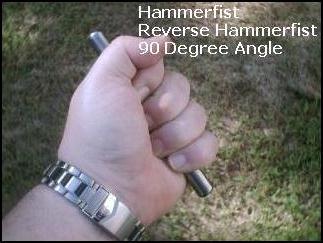
Reverse Hammerfist. A clenched fist where the top [thumb side] of the fist is the striking surface. Koppo lies across the palm at a 90 degree angle.
Thumb Strike. This is something I blatantly stole from Taijutsu. It takes some time to get used to without a Koppo, but with it, it is effortless. Koppo lies across the palm at a 45 degree angle.
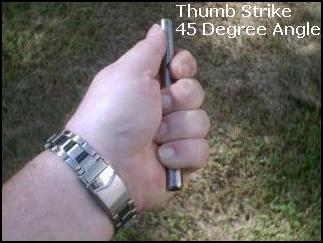

Palm Heel. This is the classic palm strike or "Tiger Claw" that can also be used with clawing and gouging the eyes, etc.
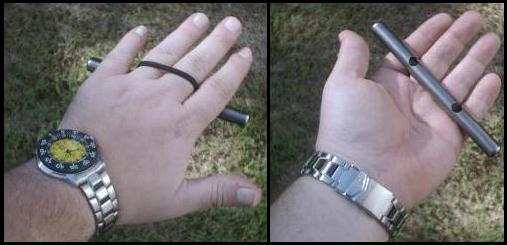
One strength of the Koppo is, it is similar to a Push Dagger in that, you can still strike with a Palm Strike and grab clothing, hair or flesh without fear of losing it. So, it has that advantage over the Kubotan and Yawara...
This is the basic theory of the Koppo Stick as I use it. It can be used with almost any martial art, but really shines when you have the mechanics and methods of the better Combat Arts behind it.
The Advanced Theory
This will be very easy for some people to grasp. Especially those in the Filipino Martial Arts who are familiar and comfortable with the Kali Thrusting Triangle and the Inverted Triangle. [See Illustrations with red triangles].
In the Illustrations, you will see a triangle and an inverted triangle. The apex of the inverted triangle can be at the groin, stomach or solar plexus. It matters not, it is a theory, the triangle can literally move on the human body like a transparency or a template. The base of the inverted triangle could be the clavicles, the sides of the neck, the sides of the head [temples] or even the eyes. You see, the Triangle moves, and it can change shape from an equilateral triangle to an isosceles, it matters not. What matters is the concept behind it.
What about the regular [non-inverted] triangle? The two points that form the base can be the kidneys, then the single point that is the apex of the triangle can be the hollow, unprotected area of the trachea between the clavicles [sometimes referred to as, "The Jugular Notch"] or between the eyes. Again, these triangles can move and they can take the shape of a regular or isosceles triangle.
This is a "thrusting map" in some styles of Kali. Apex down would be known in some Kali Systems as a, "5-8-9" Thrusting Drill. Letís go with that terminology for clarity.
Forward Grip with Koppo Stick OR Knife
#5 Would be a straight-in thrust to the stomach or solar plexus.
#8 Would be a backhanded thrust [for a right handed person] the striking hand holding the Koppo Stick or Knife would be oriented palm UP ["Nails Up" *1] and the edge of the hand would be near the LEFT pectoral muscle. Extremely tight for close quarters.
#9 Would be a forehand thrust [for a right handed person] the striking hand holding the Koppo Stick or Knife would be oriented palm DOWN ["Nails Down" *1] and be on the right side of your body.
A #5 in reverse grip could be an overhand stroke to the collarbones or the crown of the head, or, it could be low to the solar plexus which is a bit odd feeling for some people at first as the elbow is high and the back of the hand holding the weapon is facing left and the palm right.

If you know how to do alot of point work with an edged weapon, you will immediately appreciate the Koppo Stick in forward or reverse grip. The lines, attacks and everything else concerned is nearly identical. The only difference is, you can attack bone and you cannot cut.
The following pictures show relatively easy strikes, compared to what you would do under stress when you are in fear for your safety, on some wood. The wood was not rotten. After that picture, you will see some strikes into the quarterpanel of a vehicle. Think about these things if you doubt the power of a pocket stick.
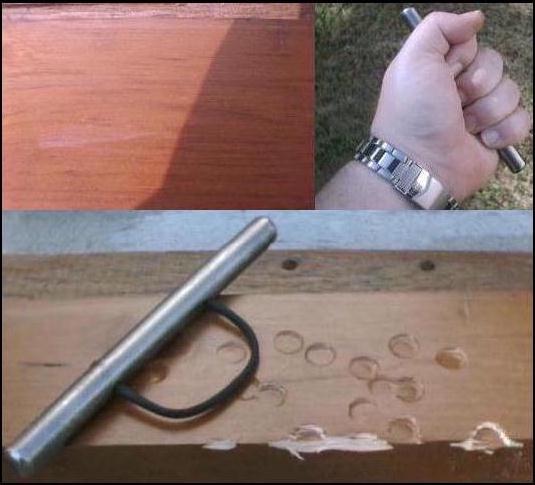
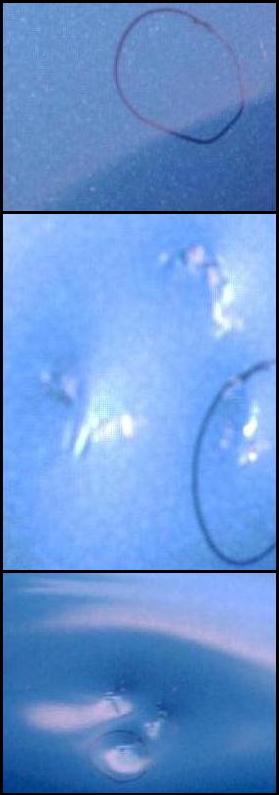
Attacking bone, Koppojutsu, bone breaking. If you have a downward thrust with a knife, you can target the subclavian arteries and/or veins behind the clavicles [collarbones], with the Koppo, you hit the collarbone. And, make no mistake, the Koppo Stick can break a collarbone.

To me, this is the Advanced Theory for using this type of tool, a common pocket stick.
Ricochet Strikes
These are just a couple of sequences for rapid fire striking.
Forearm to Head/Face:
Someone reaches out to choke you and using that as a restraint as well, may decide to punch you immediately following contact with their other hand.
With your off-hand, pin their grabbing hand in place and strike down with the Koppo in a hammerfist strike to the radial nerve area on the top of the forearm [mound]. That could be called a vertical crescent action, your palm is facing you. Immediately, the hand rotates palm down ["Nails Down"] and you strike backhanded to the side of the neck, head or into the face.
What is hard to understand until you have actually done this movement, is just how fast it is. These two hits happen in well under a second. And once the dysfunction is caused in the arm and the neck, head or face is struck, you can basically follow up however you train to. I call it a ricochet because you are banging downward on the trapped arm and with a little hand rotation, you "bounce" it off of that strike and right into the second.
Under the Upper Arm to Solar Plexus/Groin:
What if the person is clueless and thinks he can simply choke you with both hands from the front?
Attack the underside of one arm. The upper arm on the underside is extremely sensitive, and you can hit anywhere from the elbow joint area almost to the armpit with immediate results. If you use isometric exercise [The rattan hoop is my favorite] and a little bit of weightlifting [slowly] duplicating this movement with a dumbell, you can fracture the humerus as well.
Where does the "ricochet" come into play? As soon as that strike lands, which is essentially a REVERSE hammerfist, the palm of the hand holding the Koppo Stick will be oriented LEFT. Rotate the palm DOWN and fire the second shot into the solar plexus or even lower into the groin.
Make up your own rapidfire "ricochet" strikes using this as a guideline.
Basic Guideline for Multiple Attackers
I wonít insult your intelligence by listing "sequences" that go into obscene detail on how to deal with two or more attackers on the street. I will tell you about one excellent sequence that you can strike the first one with that gets in your face [inside your sphere of defense] and then with training partners, you should find out the most effective way you move and what you can uncover via personal exploration. People that delve into great detail about multiple attackers and have set methods, kata or sequence are often making things up. Rest assured, you are hardly, if ever, going to pull those techniques off because they require your attackers to be compliant while you attack them. Itís not going to happen that way. People take training vehicles and try to set them in stone and say, "This is what you will do" instead of saying, "This is something you could do, but itís just to get you to explore..."
If you have two or more attackers and it is clear they are going to attack you. Hit them first. In my opinion, there is such a disparity of force, you have to preempt them if at all possible if you want to survive.[*2]
This is the "High-Low" Principle meeting the "Head and The Hands Follow the Pain" Philosophy.
If you hit high, go low as you have created an opening. If you hit low, go high as you have created an opening.
The head and the hands will usually follow the pain. Old principle I learned from someone in GM Ed Parkerís Kenpo System. Meaning, if you strike someone really hard in the nose, 90% of the time, their hands will at least move upwards towards the pain, their head will go back a bit. A trained fighter who has been hit hard before is not necessarily going to react this way, however.
Kick a man in the groin, his head will come a bit lower and his hands will gravitate to the area of the pain. You have created an opening up high.
If you knee someone in the groin, know that their head [in most cases] is coming down and if you then knee spike them, you are multiplying force like two vehicles hitting head on.
At long range, you would know that the hands are going downward, at least a little bit and that is your open window of opportunity to go high and strike them there.
The Actual Sequence
The one "sequence" I will give you is this, if you know it is going to happen and you have to take the first attacker out of the picture[*3], this is the way it can be done. This is a rapidfire, "ricochet" type of strike as well.
Using the thumb strike, the Koppo oriented at a 45 degree angle in the hand as if you had a knife in forward saber grip...
Strike immediately and directly into the solar plexus. Again, 90% of the time, his head is coming down, meet his throat, tip of chin or the area under the tongue instantly with the Stick.
The initial thumb strike, the palm will be facing LEFT, you orient the "point" of the Koppo and keeping the palm facing left, you strike upwards, vertically straight up to meet the head coming down. You can then literally grab the throat or face and Tiger Claw them, and either slam them into another attacker, slam them down and run over them to escape, or you can get behind them and use them as a shield.
Whenever dealing with multiple attackers, you have two basic options for survival.
Hit first, hard and fast and get out of the area they have created for you to be destroyed in.
Take the first one that gets in your face, damage him, use him as a shield and at the first opportunity, shove or slam him into another attacker or otherwise dump him and escape.
Anyone that takes you money and strokes your ego going over dozens of sequences or kata teaching you how to deal with multiple attackers is simply doing just that. Stroking your ego to dip into your wallet.
Learn how to strike and learn how to maneuver using footwork and never stop moving or youíre dead meat. Thatís the rule.
[*1] "Nails Up" and "Nails Down" is referring specifically to the fingernails, very simple. Palm down or Palm up, same thing.
[*2] & [*3] This has to do with legalities. Only the Jury will decide if your actions were warranted in the particular situation you face, further;
All of the information in this article and the rest of the website is for information purposes only. I advise you to be very careful in any Martial Arts Training you decide to be involved in. I except no responsibility for misuse of this material in real life, on the street or in training. You use this at your own risk.
Much of the text and illustrations show what would be a lethal application. You must be responsible. If someone does not pose a lethal threat to you or a loved one, do not strike them in the head, throat or anywhere in the neck area. Some Police Departments Guidelines consider the collarbones as potentially lethal targets now because of the splintering effect that can occur from heavy strikes to that area. Which can possibly puncture the subclavian vessels.
If the attacker has a lethal weapon, generally speaking, you are usually justified in using lethal force to repel that attack/threat. As the disclaimer stated, I'm not responsible for the misuse of this information.
[Drawings are altered from U.S. Army Combatives Manual, Public Domain]